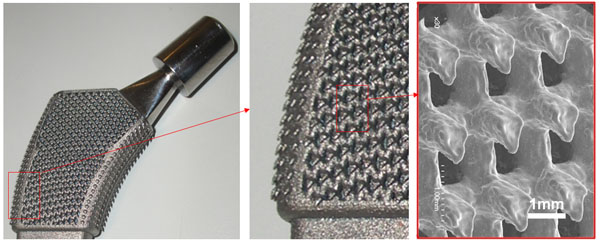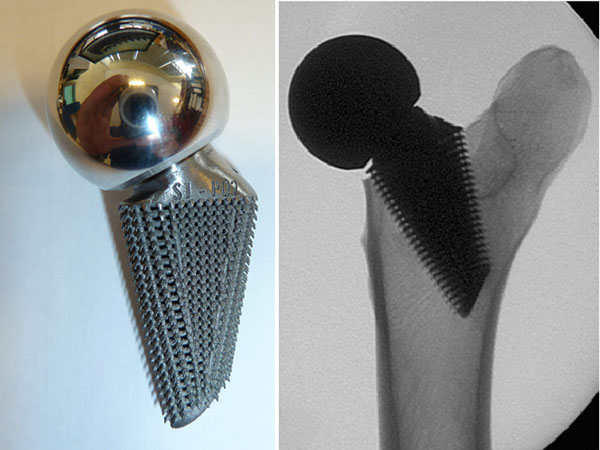Dr Pat McDonnell and Dr Noel Harrison from NUI Galway, who will be presenting their OsteoAnchor hip-replacement technology at the Big Ideas Technology Showcase
This Wednesday, Enterprise Ireland’s Big Ideas Technology Showcase will take place in Dublin. Nineteen presenters will pitch their ‘big ideas’ to potential mentors, business partners and investors, and plenty more again will be on show at the Technology Expo at the Aviva Stadium. We take a look at two of the med-tech ideas that will have their chance to shine at the event.
Sometimes the big ideas in med-tech innovation are about getting a better edge. Perhaps a hip replacement with tiny, directional claws on its surface that gives the implant a better grip in the recipient’s thigh bone. Or ‘self-cleaning’ hospital uniforms, where nanoparticles on the textile become activated by light and can kill potentially dangerous bacteria lurking on the fabric.
These are two of several innovative ideas that will be presented this week at Enterprise Ireland’s Big Ideas Technology Showcase in Dublin.
Secure that implant
The hip-replacement technology OsteoAnchor aims to overcome a problem with implants coming loose over time, explains Dr Noel Harrison, a senior research engineer at NUI Galway.
“In hip, knee, shoulder or any joint replacement, it’s crucial that there is secure fixation, that the implant is not going to move,” he says. “If there is too much relative movement between an implant and a bone, weak tissue will grow around the implant instead of hard bone tissue. That ultimately causes pain, reduces function and the implant has to be removed and replaced in another operation.”
OsteoAnchor is designed to grip the thigh bone securely and to encourage new hard bone tissue to grow into the implant. And because the claws are directional, it is relatively easy for surgeons to remove it if needed, he notes.
“The claws embed into the bone without cutting or damaging the tissue,” says Harrison. “Then in the layer underneath the claws we have a lattice of tiny struts, and bone can grow in through these structures.”

An OsteoAnchor hip stem (left) with a zoom-in view of the claws and lattice structure (centre and right images)

OsteoAnchor architecture applied to a short hip stem design (left); X-ray of device implanted in cadaver femur (right)
OsteoAnchor is made from a standard titanium alloy, but the manufacturing process is quite novel, as Harrison describes.
“We use a rapid prototyping technology called DMLS, which is similar to 3D printing,” he says. “You start off with a bed of very fine loose titanium powder. A laser on the top of the machine points at the bed and sinters out a 2D slice of implant before more loose powder is spread on top. The laser then sinters the next layer to the previous one and so on, thereby building the implant slice-by-slice.”
The preclinical study of an OsteoAnchor hip replacement showed the technology immediately grips the bone effectively, that recovery after surgery is quicker and – most essentially – the hip replacements remain very secure due to extensive bone in growth, according to Harrison. The team is now moving towards clinical trials.
“We have put together a team of orthopaedic surgeons to work with us to design a hip implant with OsteoAnchor,” he says. “The target application is a revision hip stem, those are for patients having their second or third hip replacement in the same leg – that is one of the most challenging kinds of orthopaedic surgery, and it’s where OsteoAnchor can make a huge impact. In the future we hope to have OsteoAnchor knee and shoulder implants, but for now we are concentrating on hips.”
Self-sterilising uniforms
Another technology with the surface in mind is Nanoplast, which looks to combat healthcare-associated infection with just the flick of a light switch or a walk outside. Developed by an EU-funded project led by the University of Limerick (UL), the technology puts light-activated nanoparticles onto the surface of textiles.
In practice, that would mean that someone wearing a uniform in a hospital could sterilise their clothes simply by spending time in a lit room, or going for a walk outside in sunlight, explains Dr Patrick Cronin, who is on the research team at UL.
The study showed that light-activated titanium nanoparticles on the textiles are active against MRSA, and when silver-doped titanium nanoparticles on the textiles were exposed to light, they killed E. coli. And even after 40 washes, the Nanoplast-treated textile was still able to combat bacteria, notes Cronin.
The EU-funded project has now finished, but through Enterprise Ireland and the Technology Transfer Office at UL, the team is now developing the technology for scale-up and commercialisation.
Economic relevance
Seán Sherlock, Ireland’s Minister for Research and Innovation, will be at Big Ideas to present commercialisation awards.
He tells Siliconrepublic.com the event highlights the economic relevance of publicly funded research that’s managed through agencies, such as Enterprise Ireland and Science Foundation Ireland: “It’s a great showcase for where that spend is going.”
Industry engagement on the day is vital to its success, he adds.
“This will lead to new spin-out companies, to increased licensing of technologies and to growing existing Irish companies,” says Sherlock. “It’s also an ideal opportunity for people to establish contacts in academia and industry.”
Enterprise Ireland’s Big Ideas Technology Showcase takes place at the Aviva Stadium in Dublin on 28 November.
Siliconrepublic.com is hosting Med Tech Focus, an initiative which over coming months will cover news, reports, interviews and videos, documenting Ireland’s leading role in one of the hottest sectors in technology.